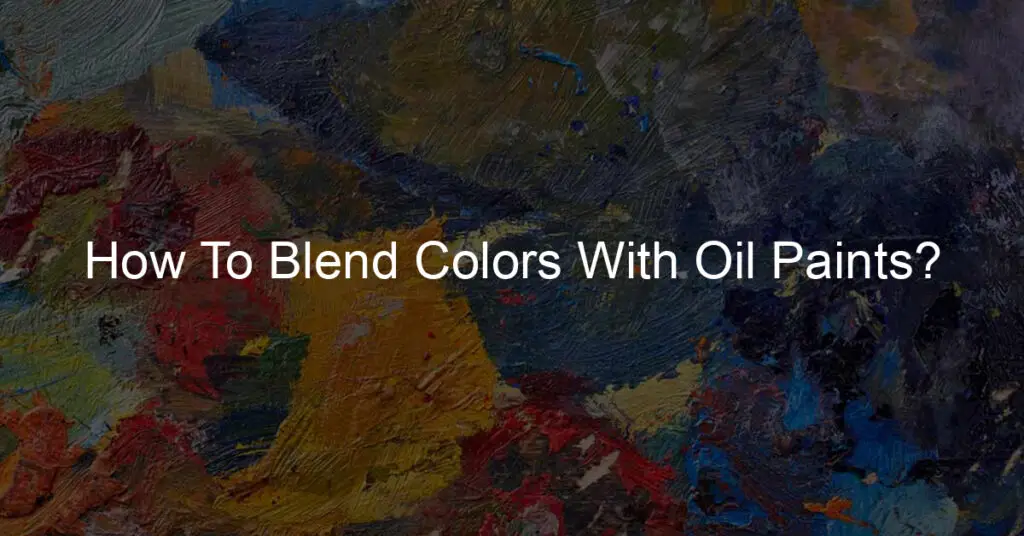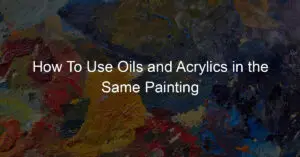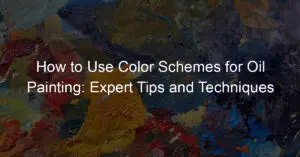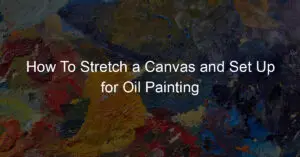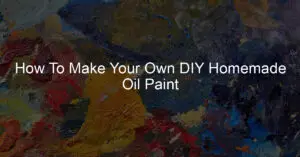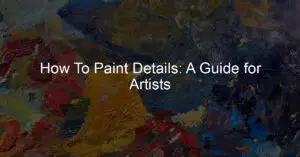Blending colors with oil paints can elevate your art by creating a smooth transition from one hue to another and adding depth to your work.
Mastering this technique is essential for any painter, whether you are a beginner or a seasoned artist. With a little bit of practice and patience, you will be able to blend colors flawlessly and achieve stunning visual effects on your canvas.
Before delving into blending techniques, it’s important to understand the properties of oil paints. Oils are known for their slow drying time, making it easier to mix and manipulate colors for extended periods. This unique characteristic allows artists to achieve seamless blending and create rich, vibrant tones.
The key to successful blending lies in understanding color theory, utilizing the right tools, and employing a variety of techniques, such as wet-into-wet, glazing, and scumbling. Exploring these methods will help you discover which works best for your artistic vision and enable you to create captivating oil paintings that exude depth and beauty.
Understanding Color Theory
Color theory is a fundamental aspect of working with oil paints. It refers to the study of how colors interact, blend, and contrast with one another. To blend colors successfully, it is crucial to comprehend the relationships between various colors on the color wheel.
The color wheel features three types of colors: primary, secondary, and tertiary. Primary colors are red, blue, and yellow, which cannot be created by mixing other colors. Secondary colors are the result of blending two primary colors together: green (blue and yellow), orange (red and yellow), and purple (red and blue). Tertiary colors are created when a primary color is mixed with a secondary color, resulting in six additional hues like red-orange, yellow-green, and blue-purple.
A helpful tool for blending colors is the color chart. A color chart serves as a reference to see how individual colors mix and create new shades. By organizing colors according to their relationships on the color wheel, it is easier to plan color combinations and understand how to create harmony within a piece of art.
Complementary colors are those that sit directly opposite one another on the color wheel. They have a strong visual contrast and can make each color appear more vibrant. For example, green and red are complementary colors, and mixing both oil paints together will result in a desaturated, neutral shade. Combining complementary colors is an effective way to achieve depth and balance in your artwork.
When blending oil paints, it is essential to use a color mixing guide as not all colors mix predictably. Some pigments are more dominant than others, so follow a guide to ensure the desired shade is achieved. Remember that practice is key; experimenting with different hues and color combinations will help you become more confident and knowledgeable in color mixing.
Selecting Materials and Supplies
When starting your oil painting journey, it’s essential to have the right materials and supplies. Begin by choosing high-quality oil paints. There is a wide variety of colors and brands available, so select those that suit your preferences and budget.
A proper painting surface is crucial for oil painting. Stretched canvas and canvas boards are the most common surfaces for oil painters. Stretched canvas is lightweight and portable, while canvas boards are more rigid and provide extra support. Choose a surface that meets your needs in terms of size and texture.
Selecting the best oil paint brushes is also vital. There are two main types of brushes for oil painting: natural hair and synthetic brushes. Natural hair brushes tend to be more expensive but offer better paint application and control. Synthetic brushes are affordable and suitable for beginners. It’s a good idea to have a variety of brush sizes and shapes to achieve different effects and strokes in your painting.
You’ll also need a palette to mix and hold your paints. Palettes come in various materials, such as plastic, wood, and glass. Choose a palette with enough space for mixing colors and one that is easy to clean.
A palette knife is a useful tool for mixing colors and applying thick layers of paint on the canvas. They come in different shapes and sizes, so choose one that feels comfortable in your hand and is suitable for the techniques you plan to use.
Always have a clean rag or cloth handy for wiping brushes and palette knives. Keeping your tools clean while working will help you maintain control of your colors and prevent unwanted color mixing.
For thinning your oil paints and cleaning your brushes, you will need a solvent. Turpentine and odorless mineral spirits are popular choices. Always use solvents in a well-ventilated area and follow the manufacturer’s safety instructions.
Lastly, consider having a bottle of linseed oil on hand. This oil is used to modify the consistency of your paints and can help improve their flow on the canvas. It also helps to preserve the painting’s brightness and vibrancy over time.
By selecting the right materials and supplies, you’ll have a strong foundation for creating beautiful and lasting oil paintings.
Preparing the Surface and Setting Up
To begin blending colors with oil paints, it is essential to have a well-prepared surface and properly set up your workspace. A smooth surface allows oil colors to blend more easily and creates a more visually appealing result.
Choose a suitable surface such as a stretched canvas, a wooden panel, or a rigid surface primed with gesso. Priming your surface with gesso ensures that it is adequately sealed, providing a base that will adhere well to the oil paint.
Once you have selected and prepared your surface, you can set up your workspace with the necessary tools and materials:
- Oil colors: Opt for high-quality oil paint, as it will make blending much smoother. Have a variety of colors available, including primary colors (red, blue, and yellow) and secondary colors (green, orange, and purple).
- Color palette: A clean, flat surface for mixing your oil colors is essential. Wooden or glass palettes work well, as they provide a smooth surface that allows for effortless color blending.
- Paintbrushes: Select brushes with different shapes and sizes that are specifically intended for use with oil paint. These brushes will offer better control and precision when blending colors.
- Paper towels: Keep a pack of clean paper towels close to your workspace to maintain the cleanliness of your brushes when blending. Wipe your brushes frequently to prevent the mixing of unwanted colors.
- Paper towel container: To dispose of used paper towels and maintain a tidy workspace, having a container is practical.
Now that your surface is prepared, and your workspace is ready, you can confidently proceed with blending colors using oil paints. Remember to follow proper techniques and enjoy the creative process in achieving harmonious color blends.
Basic Blending Techniques
Blending colors with oil paints can be a rewarding and enriching experience as you discover the nuances of color mixing and create smooth transitions. Here are some basic blending techniques to help you get started.
First and foremost, it’s important to have a proper set of brushes. A variety of sizes and shapes will help you achieve the desired blending effects. Flat, round, and filbert brushes are some popular choices for blending oil paints.
Start by preparing your color palette. Before blending, it is essential to mix the colors you want to use. Pick the primary colors you would like to blend, and then mix them on the palette to create your desired shades. Avoid using too much paint, as it can lead to waste and increase the drying time.
One effective blending technique is called wet-on-wet, which involves applying wet paint over wet paint. This method helps to create a seamless transition between colors.
To achieve this effect, first, apply a base color to the area of the canvas you want to blend. Next, quickly add the second color while the first is still wet, and blend them using a clean, dry brush, working in small, circular motions. Use a light touch, allowing the colors to merge.
Another approach is called glazing. It involves applying a thin, transparent layer of paint over a dry, opaque layer.
This technique requires patience and a thorough understanding of the drying times of oil paints. Start by applying a thin layer of a lighter color over the base color and wait for it to dry completely. Next, apply a thin, transparent layer of a darker color over the light layer. This will create a smooth gradient between the two colors.
Lastly, a technique known as scumbling can also be used for blending colors. It involves applying a thin layer of opaque paint over a dry layer, using a dry brush for a textured effect. This method is ideal for creating atmospheric effects, and it can create a rough, irregular blending.
Remember, practice is the key to mastering these basic blending techniques. The more you experiment, the more comfortable you will become in your learning process.
By incorporating these different techniques into your painting, you can create a wide range of visual effects and elevate your artwork to new heights.
Mixing and Manipulating Colors
To create a variety of colors in oil painting, it is essential to understand the basics of color mixing. The three primary colors are red, yellow, and blue. By combining these colors in various proportions, you can create a wide range of hues.
To create secondary colors, mix equal amounts of two primary colors. For example, mixing red and yellow will produce orange. To create a neutral gray or brown, mix all three primary colors in suitable proportions, or combine complementary colors.
Always use high-quality oil paints. For a clean and vibrant color palette, consider using titanium white, phthalo blue, burnt umber, yellow ochre, and magenta. These are versatile and mix well with other colors.
To achieve a smooth mixing of colors in an oil painting, follow these steps:
- Start by preparing your palette with the desired colors.
- Mix primary colors to create secondary colors or intermediate colors if needed.
- Gradually add white or burnt umber to the color mixture to lighten or darken the color.
- Use a palette knife to mix colors thoroughly before applying them to the canvas.
Here are some commonly used color combinations:
- For a natural sky color, mix phthalo blue and titanium white.
- For a warm earth tone, mix yellow ochre, burnt umber, and a small amount of red.
- To create a soft green, combine yellow and phthalo blue.
While mixing colors, maintain a neutral and clear state of mind. Practice will make you more confident and knowledgeable in blending colors with oil paints. Remember, experimenting with different color combinations will help you achieve the desired outcome and enhance your painting skills.
Creating Depth and Shading
When working with oil paints, creating depth and shading is essential for achieving a realistic and visually appealing piece. To do this, consider the following aspects:
First, focus on shading. Shading is the technique of using different values to create the illusion of depth. Start by determining your light source, which will dictate where the highlights and shadows appear. The closer your subject is to the light source, the brighter and more intense the highlights will be. Conversely, the further away your subject is from the light source, the more subtle and diffused the highlights will become.
Now, let’s discuss hue, tone, and intensity. Hue refers to the basic color, the tone is the relative lightness or darkness of a color, and intensity is the brightness or dullness of a color. To create depth, you will need to vary these three aspects in your painting. Keeping your light source in mind, you can add more white paint to create a lighter tone for the highlights and more black paint to create darker tones for the shadows.
Next, understand the importance of values in your painting. Values are the different shades of brightness and darkness in a color. To create depth, use high contrast values.
This means using a wide range of values, from light to dark, to portray the form and distance of objects in your painting. To achieve a sense of depth, it’s crucial to gradually change the value as you move away from the light source.
Another aspect to consider is distance. To convey distance in your painting, objects farther away should have less contrast and detail. Colors will appear more neutral, and there will be less value contrast between highlights and shadows. This helps create an atmospheric perspective and enhances the perception of depth in your artwork.
In summary, pay attention to shading, hue, tone, intensity, values, depth, highlights, shadows, light source, and distance in your oil painting. By giving thought to these elements, you can create a visually stunning piece with depth and dimension that showcases your skill as an artist.
Applying Blending Techniques for Different Effects
Blending oil paints effectively can greatly enhance the visual impact of your artwork. By understanding and employing different techniques, you can create a variety of effects that add depth, texture, and visual interest to your pieces.
One fundamental difference between oil and acrylic paints is that oil paints have a much longer dry time. This extended drying period allows for more time to blend and create smooth transitions between colors. However, it’s important to remember that water and acrylics should not be used with oil paints, as they aren’t compatible with one another.
Good To Know: Impasto is a thick, textured painting technique where the paint is applied in thick layers, creating a three-dimensional effect.
To achieve this with oil paint, you will need to apply the paint in heavy strokes using a brush or palette knife. The texture generated by impasto can add dimension and a tactile element to your work.
Scumbling involves applying a thin layer of oil paint over a dry or partly dry underpainting. This technique allows some of the original color to show through while adding a sense of texture. The drier nature of scumbling can create exciting effects when contrasted with the smooth, wet blending of adjacent areas.
Glazing is a technique where thin layers of transparent oil paint are applied over completely dry underpainting. The purpose of glazing is to create depth, change the hue, or adjust the tone of a painting.
Use a soft brush and a glazing medium to dilute your paint, then apply a thin, even layer to the desired area. You may need to apply multiple glazes to achieve the desired effect, allowing each layer to dry before applying the next.
Underpainting involves laying down an initial layer of paint to establish the colors and values in your composition. This layer is usually kept thin and may be in monochrome or a limited color palette. When blending oil paints, you can use underpainting as a foundation for other blending techniques to create more complex and refined effects.
As you explore these blending techniques with oil paints, you will develop a greater understanding of the unique properties of this medium. With practice and experimentation, you can confidently create a wide range of artistic effects to elevate your work.
Cleaning and Caring for Brushes
Cleaning and caring for your oil paint brushes is essential to ensure they remain in good condition and can continue to produce beautiful brushstrokes.
To clean your brushes, first, wipe off excess paint using a paper towel or cloth. This will help to remove most of the paint and make the cleaning process easier. Next, dip the brushes into a cleaning solution specifically designed for oil paints. Gently swirl the brushes in the solution to loosen and remove the remaining pigment. Be careful not to damage the bristles by pressing too hard.
After this, rinse the brushes in warm water and gently reshape the bristles with your fingers. Lay them flat on a clean surface to dry. Make sure the brushes don’t rest on their bristles as this will cause them to become misshapen over time.
Different types of brushes require different care. Flat brushes, for example, are ideal for covering large areas and creating straight lines. They often get dirty more quickly, so make sure to clean them at least once during a painting session.
Mop brushes and soft brushes are good for blending colors but tend to hold on to paint more than other brushes. To maintain their effectiveness, clean them thoroughly and be sure to store them correctly.
It’s important to note that you may still see some brush marks when using oil paints, even with proper care of your brushes. These marks are a natural part of the oil painting process and often contribute to the uniqueness of the artwork.
Remember, by taking care of your brushes, you’ll be able to create stunning oil paintings with impressive brushstrokes for years to come.
Developing Your Skills and Style
As a beginner in oil painting, it’s important to practice regularly to develop your skills and find your own unique style. Start by familiarizing yourself with different painting techniques and don’t be afraid to experiment. This will help you in your transition from a novice to a more experienced artist.
One way to improve is by recreating realistic paintings from reference images or paintings done by other artists. This not only helps you understand the subtleties of color blending but also teaches you about composition and the importance of light and shadow. Remember, practice is key, and the more you practice, the better your paintings will become.
Here are some techniques and tips to consider:
- Layering: Apply thin layers of paint, allowing each layer to dry before applying the next. This creates depth and helps you achieve smooth color transitions.
- Glazing: Combine transparent oil paint with a medium to create glazes that can be applied over dried layers of paint, altering the color and tone of the underlying layers.
- Dry brush: Use a brush with very little paint and no thinner to create a textured and rough finish. This technique is helpful for adding details or creating an expressive style.
- Scumbling: Apply a thin layer of opaque paint over a dried underpainting, allowing some of the raised textures to remain visible. This creates a more tactile and interesting surface.
Additionally, don’t hesitate to explore different styles and subjects, such as abstract, landscapes, portraits, or still life. This will help you develop your preferences and discover your own unique approach to oil painting.
Finally, always be open to feedback and constructive criticism. Connecting with fellow artists and joining workshops or classes can be beneficial in building your skills and style.
Frequently Asked Questions
What are the best techniques for blending oil paint on canvas?
There are several ways to blend oil paints effectively on canvas. Wet-on-wet or alla prima technique involves applying fresh paint onto still-wet layers, giving a smooth blended appearance. Another technique is called scumbling, where a dry brush is used to apply thin layers of paint on top of other areas to create a smoother transition.
How can I create smooth transitions between colors in oil paintings?
For smooth transitions, maintain a clean brush while blending the two neighboring colors. Start with the lighter color and gradually move into the darker shade, ensuring the paint remains wet throughout the process. This method allows the edges to blend seamlessly, providing a smooth transition between colors.
What type of brush is recommended for blending oil paints?
Soft brushes, usually made from sable or synthetic fibers, are ideal for blending oil paints. Round, flat, or filbert shapes are commonly used, depending on the blending style and the desired level of detail. Choose a brush size that is proportionate to the area being blended for better control.
Can you provide some oil paint shading techniques?
Oil paints offer flexibility for various shading techniques. The most common methods are wet-on-wet blending, glazing, and scumbling, which are used for creating soft, smooth gradients and subtle tonal shifts. Cross-hatching, stippling, or impasto can add texture and depth to the painting.
How do oil pastels differ from oil paints in terms of blending?
Oil pastels have a soft, waxy consistency that sits on the paper’s surface. They can be blended with tools like fingers or blending stumps, producing a smooth gradient. In contrast, oil paints are more fluid and viscous, requiring brushes or other tools for blending on a canvas.
What factors make oil paints easier or more difficult to blend?
Oil paint blending can be influenced by factors like paint viscosity, drying time, and pigment intensity. High-quality oil paints with a smooth consistency and sufficient drying time are easier to blend. Certain pigments may affect blending, so it’s essential to consider the color combination and compatibility. Ensuring an even application will also help in achieving smoother transitions.

